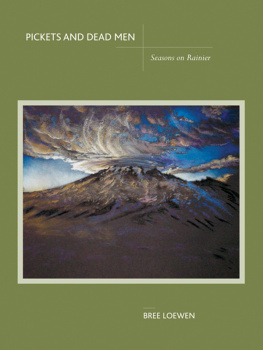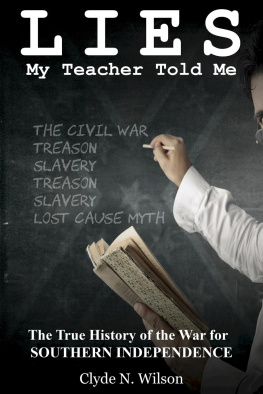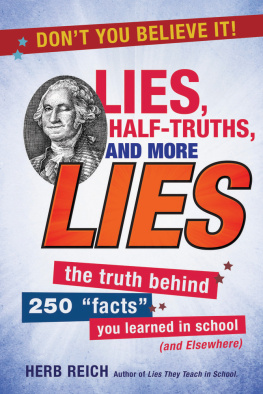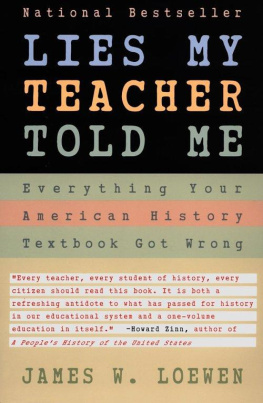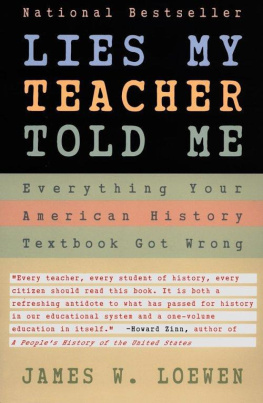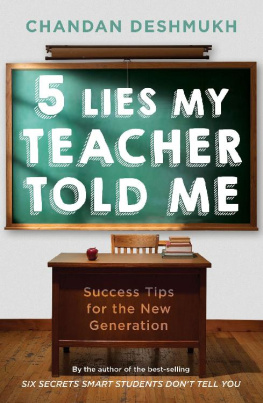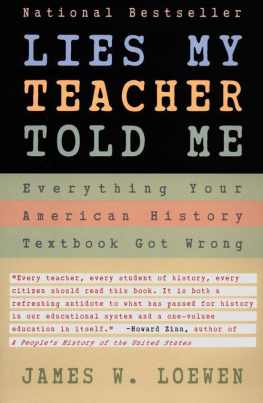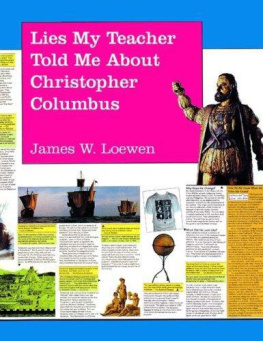James W. Loewen is the bestselling and award-winning author of Lies Across America, Lies My Teacher Told Me About Christopher Columbus, and Sundown Towns (all published by The New Press) as well as Teaching What Really Happened, The Mississippi Chinese, and The Confederate and Neo-Confederate Reader. He has won the American Book Award, the Oliver Cromwell Cox Award for Distinguished Anti-Racist Scholarship, the Spirit of America Award from the National Council for the Social Studies, the Gustavus Myers Outstanding Book Award, and the Cox-Johnson-Frazier Award from the American Sociological Association. Loewen is professor emeritus of sociology at the University of Vermont and lives in Washington, D.C.
ALSO BY JAMES W. LOEWEN
The Confederate and Neo-Confederate Reader: The Great Truth About the Lost Cause (editor, with Edward H. Sebesta)
Lies Across America: What Our Historic Sites Get Wrong
Lies My Teacher Told Me About Christopher Columbus
The Mississippi Chinese: Between Black and White
Mississippi: Conflict and Change (with Charles Sallis et al.)
Social Science in the Courtroom
Sundown Towns: A Hidden Dimension of American Racism
Teaching What Really Happened: How to Avoid the Tyranny of Textbooks and Get Students Excited About Doing History

1995, 2007, 2018 by James W. Loewen
Preface 2018 by James W. Loewen
All rights reserved.
No part of this book may be reproduced, in any form, without written permission from the publisher.
Requests for permission to reproduce selections from this book should be mailed to: Permissions Department, The New Press, 120 Wall Street, 31st floor, New York, NY 10005.
ILLUSTRATION AND TEXT CREDITS
13, National Archives; 15, Smithsonian Institution; 44, Lee Boltin; 49, 58, Library of Congress; 59, New York Public Library; 109, Library of Congress; 112, Smithsonian Institution; 115, Library of Congress; 119, D. W. Meinig/Yale University Press; 120, Library of Congress; 129, Division of Parks, Recreation, and Historic Sites, Georgia Department of Natural Resources; 133, Amway Environmental Foundation; 169, Scott Nearing; 187, Collection of architectural toys and games, Canadian Centre for Architecture/Centre Canadien dArchitecture, Montral, acquired with the support of Bell Qubec; 202, Mississippi Department of Archives and History; 205, Andrea Ades Vasquez, American Social History Project; 210, Miller Brewing Co.; 219 (What Did You Learn in School Today? by Tom Paxton), 1962, 1990 Cherry Lane Music Publ. Co., all rights reserved, used by permission; 223, Bettmann/Corbis; 246, 247, 248, AP/Wide World Photos; 249 (left) Ronald L. Haeberle/Life magazine Time Warner, (right) Bettmann/Corbis; 251, Fred Ward/Black Star; 272, Walter Reed Army Medical Center; 277, Mother Jones; 283, Boy Scouts of America; 310, The Norman Rockwell Agency.
Originally published in the United States by The New Press, New York, 1995
This edition published in the United States by The New Press, New York, 2018
Distributed by Two Rivers Distribution
ISBN 978-1-62097-455-1 (ebook)
CIP data is available
The New Press publishes books that promote and enrich public discussion and understanding of the issues vital to our democracy and to a more equitable world. These books are made possible by the enthusiasm of our readers; the support of a committed group of donors, large and small; the collaboration of our many partners in the independent media and the not-for-profit sector; booksellers, who often hand-sell New Press books; librarians; and above all by our authors.
www.thenewpress.com
10 9 8 7 6 5 4 3 2 1
Dedicated to all American history teachers
who teach against their textbooks
(and their ranks keep growing)
ACKNOWLEDGMENTS
TO THE FIRST EDITION

THE PEOPLE LISTED BELOW in alphabetical order talked with me, commented on chapters, suggested sources, corrected my mistakes, or provided other moral or material aid. I thank them very much. They are: Ken Ames, Charles Arnaude, Stephen Aron, James Baker, Jose Barreiro, Carol Berkin, Sanford Berman, Robert Bieder, Bill Bigelow, Michael Blakey, Linda Brew, Tim Brookes, Josh Brown, Lonnie Bunch, Vernon Burton, Claire Cuddy, Richard N. Current, Pete Daniel, Kevin Dann, Martha Day, Margo Del Vecchio, Susan Dixon, Ariel Dorfman, Mary Dyer, Shirley Engel, Bill Evans, John Fadden, Patrick Ferguson, Paul Finkelman, Frances FitzGerald, William Fitzhugh, John Franklin, Michael Frisch, Mel Gabler, James Gardiner, John Garraty, Elise Guyette, Mary E. Haas, Patrick Hagopian, William Haviland, Gordon Henderson, Mark Hilgendorf, Richard Hill, Mark Hirsch, Dean Hoge, Jo Hoge, Jeanne Houck, Frederick Hoxie, David Hutchinson, Carolyn Jackson, Clifton H. Johnson, Elizabeth Judge, Stuart Kaufman, David Kelley, Roger Kennedy, Paul Kleppner, J. Morgan Kousser, Gary Kulik, Jill Laramie, Ken Lawrence, Mary Lehman, Steve Lewin, Garet Livermore, Lucy Loewen, Nick Loewen, Barbara M. Loste, Mark Lytle, John Marciano, J. Dan Marshall, Juan Mauro, Edith Mayo, James McPherson, Dennis Meadows, Donella Meadows, Dennis Medina, Betty Meggars, Milton Meltzer, Deborah Menkart, Donna Morgenstern, Nanepashemet, Janet Noble, Roger Norland, Jeff Nygaard, Jim OBrien, Wardell Payne, Mark Pendergrast, Larry Pizer, Bernice Reagon, Ellen Reeves, Joe Reidy, Roy Rozensweig, Harry Rubenstein, Faith Davis Ruffins, John Salter, Saul Schniderman, Barry Schwartz, John Anthony Scott, Louis Segal, Ruth Selig, Betty Sharpe, Brian Sherman, David Shiman, Beatrice Siegel, Barbara Clark Smith, Luther Spoehr, Jerold Starr, Mark Stoler, Bill Sturtevant, Lonn Taylor, Linda Tucker, Harriet Tyson, Ivan Van Sertima, Herman Viola, Virgil J. Vogel, Debbie Warner, Barbara Woods, Nancy Wright, and John Yewell.
Three institutions helped materially. The Smithsonian Institution awarded me two senior postdoctoral fellowships. Members of its staff provided lively intellectual stimulation, as did my fellow fellows at the National Museum of American History. Interns at the Smithsonian from the University of Michigan, Johns Hopkins, and especially Portland State University chased down errant facts. The flexible University of Vermont allowed me to go on leave to work on this book, including a sabbatical leave in 1993. Finally, The New Press, Andr Schiffrin, and especially my editor, Diane Wachtell, provided consistent encouragement and intelligent criticism.
TO THE SECOND EDITION

AS I ENDURED THE MORAL and intellectual torture of subjecting myself to six new high school American history textbooks in 200607, the following assisted in important ways: Cindy King, David Luchs, Susan Luchs, Natalie Martin, Jyothi Natarajan, the Life Cycle Institute and Department of Sociology at Catholic University of America, and Joey the guide dog in training. Many of the folks thanked for their assistance with the first editionincluding those at The New Pressalso helped this time. So did Amanda Patten at Simon & Schuster.
CONTENTS

Table of Contents
Guide




